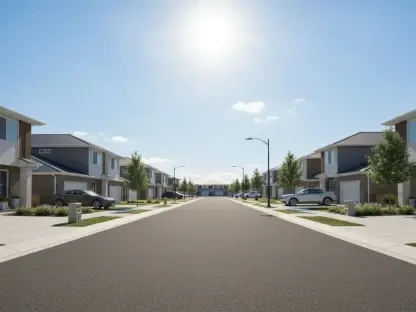Imagine stepping into a home where every corner tells a story, where functionality meets artistry in the most unexpected ways, transforming mundane spaces into captivating retreats that inspire and delight. Architectural alcoves, the latest darling of interior design, are making waves by redefining the very essence of kitchens and bathrooms. These built-in nooks and recessed spaces are not just about aesthetics; they offer a seamless blend of practicality and charm, carving out areas that maximize space while adding a touch of personality. As homeowners increasingly seek designs that balance form and function, alcoves have emerged as a powerful solution, turning ordinary rooms into extraordinary showcases of style. From cozy breakfast nooks to elegantly framed bathtub enclosures, this trend is reshaping how living spaces are perceived and utilized, proving that even the smallest indentations can have a monumental impact on a home’s ambiance and efficiency.
Innovative Applications in Kitchen Design
Alcoves are revolutionizing kitchen layouts by introducing versatile recessed spaces that cater to a variety of needs, both decorative and functional. These architectural features can range from subtle niches perfect for displaying cherished cookbooks or vibrant herb planters to expansive floor-to-ceiling alcoves that house entire coffee bars or intimate dining spots. A particularly striking application is seen above ranges or cooktops, where alcoves transform traditional range hoods into sophisticated focal points. Hidden shelves or spice racks tucked within these spaces not only declutter countertops but also elevate the kitchen’s visual appeal. This clever integration ensures that every inch of space is utilized effectively, making alcoves a game-changer for kitchens of all sizes. Homeowners now have the opportunity to blend utility with design, crafting environments that feel both organized and inviting, while also reflecting personal tastes through thoughtful customization of these unique areas.
Beyond their practical uses, alcoves in kitchens are becoming canvases for creative expression, allowing for bold design choices that set a home apart. Designers are enhancing these spaces with decorative arches, intricate trim, or contrasting materials that draw the eye and add depth to the room. Lighting plays a crucial role as well, with options like recessed uplighting or stylish pendants highlighting the alcove’s features and turning them into statement pieces. Whether it’s a small niche painted in a daring hue or a larger alcove adorned with textured wallpaper, these elements inject character into what might otherwise be overlooked corners. This trend underscores a shift toward personalized spaces that prioritize individuality without sacrificing functionality. Kitchens are no longer just places to cook; they are evolving into hubs of creativity where alcoves serve as both practical solutions and artistic highlights, seamlessly merging everyday needs with aesthetic desires.
Transforming Bathroom Aesthetics and Utility
In bathrooms, alcoves are carving out a niche as indispensable design elements that enhance both storage and ambiance, redefining the space as a sanctuary of relaxation. These recessed areas are increasingly used to frame bathtubs, showers, or vanities, creating a sense of enclosure that feels both timeless and intimate. A notable shift has been observed in the preference for alcove bathtubs over freestanding models, as they offer a practical yet elegant solution that promotes a cocoon-like comfort. Additional alcoves near sinks or toilets provide much-needed storage for toiletries, keeping essentials within reach while maintaining a clutter-free look. This thoughtful integration of recessed spaces addresses the common challenge of limited bathroom square footage, proving that even the smallest areas can be transformed into functional and beautiful retreats through strategic design choices that prioritize both utility and visual harmony.
Moreover, the customization of alcoves in bathrooms opens up endless possibilities for adding unique touches that elevate the overall atmosphere. Designers are experimenting with contrasting tiles, luxurious drapery, or even bold paint colors to make these spaces stand out as focal points. The addition of strategic lighting, such as sconces or subtle recessed fixtures, further accentuates their charm, casting a warm glow that enhances the mood. These elements work together to create an environment that feels personal and curated, turning a purely functional room into a space of indulgence. Alcoves in bathrooms are not just about solving spatial constraints; they represent an opportunity to infuse style and character, aligning with broader design trends that value individuality. As a result, bathrooms are evolving into more than just utilitarian areas—they are becoming expressions of personal taste, where every detail, including the humble alcove, contributes to a cohesive and inviting aesthetic.
The Lasting Impact of Alcove Integration
Reflecting on the journey of alcoves in home design, it’s evident that their integration has marked a significant shift in how kitchens and bathrooms are conceptualized over recent years. These architectural features have redefined spatial dynamics, offering solutions that balance the need for storage and style with remarkable finesse. Their ability to adapt to diverse design preferences, from minimalist to ornate, underscores their versatility, making them a staple in countless homes. Looking ahead, the influence of alcoves invites exploration into how other architectural elements might similarly transform living spaces. Homeowners and designers are encouraged to consider innovative ways to incorporate such features, perhaps by experimenting with new materials or layouts that push the boundaries of traditional design. As the conversation around functional beauty continues to evolve, alcoves stand as a testament to the power of thoughtful design, inspiring future trends that prioritize both practicality and personal expression in equal measure.









